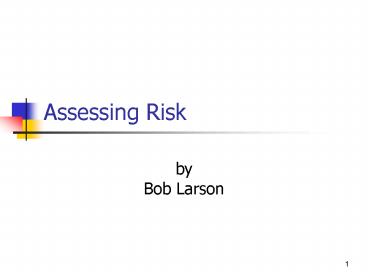Assessing Risk PowerPoint PPT Presentation
1 / 17
Title: Assessing Risk
1
Assessing Risk
- byBob Larson
2
Learning Objectives
- Identifying Risks
- Risk Analysis Techniques
- Planning for Risks
- Responding to Risks
- Contingency Planning
- Risk Management Plan
3
What is Risk?
- Event that poses a potential threat or
opportunity to the project in some way - Doesnt really matter if it is a threat or
opportunity if you dont identify before it
passes - Worst case cause the project to fail
- Can mean rework or rethinking
4
What is Risk Management?
- Multi-step process
- Identify risks
- Analyze risk and assess the impact if it happens
- Determine the probability
- Combine the impact and probability analysis
- Develop a risk response plan
- Occurs throughout project life
- Good skills help ensure project success
- Greatest project risk is early in the project
5
Advantages of Risk Management
- Helps to identify showstoppers early
- Can develop contingency plans
- Helps to identify potential opportunities
- Can create new projects or phases
- Can reduce rework and related costs
- Allows you to be proactive not reactive
- Increases credibility and reputation
- Increases likelihood of project success
6
Identifying Risks
- Types of Project Risks
- Common Project Risks
- Identification Techniques
7
Types of Project Risks
- Known risks with predictable outcomes
- Bad weather canceling an event
- Known risks with uncertain outcomes
- Low turnout will the event breakeven
- Unknown risks
- No way to predict food-born illness
8
Common Project Risks
- Constraint-related risks
- Limit the project team
- Know early on in the process
- Use the WBS (task list) to help define
- Business risks
- Marketability
- Timing
- Management issues
- Vendor delays
- External project risks
- Political, legal, environmental (weather) and
social issues - Other risks
- Lack of team project experience
9
Business risks
- Marketability
- Will customers come (or pay)
- What if the target audience doesnt see the value
- Timing
- Hitting the market at the right time
- What about regulatory delays (FDA, etc)
- Management issues
- Management turnover changes in strategies
- Business cutbacks, layoffs, budget restrictions
- Vendor delays
- Contract negotiation delays and issues
- Vendor failure or project abandonment
10
Identification Techniques
- Historical information (past projects)
- Brainstorming
- Delphi technique
- Questionnaire to identify risks (iterative)
- Removes bias and relational influences (sucking
up) - Nominal group technique
- Brainstorming with post-its (iterative)
- Interviews
- Multiple levels
- Checklist of common project risks
11
Risk Analysis Techniques
- Risk Probability and Impact
- Probability high, medium, low
- Express as a percent (25 yes 75 no 1)
- Assigning risk impacts
- Express as a numeric value
- Probability impact matrix
- Combining probability times risk (next slide)
- Risk Tolerance
- Amount of risk one is willing to (or can) tolerate
12
Probability Impact Matrix
13
Planning for Risks
- Risk is highest early in the project cycle and
diminishes as the cycle progresses - Impact of unidentified risk grows as the project
cycle progresses - Planning for risk typically reduces the impact
- Risk Response Plan
- Detailed plans to detail with risk if they occur
14
Responding to Risks
- Accepting
- Dont make contingency plans
- Accept the result if the worst occurs
- Avoiding
- Take steps to eliminate the cause of the risk
- Transferring
- Assign handling risk to 3rd party - insurance
- Mitigating
- Reduce the risk and thereby the impact
15
Contingency Planning
- Process of planning for known risks to ensure
project success - Residual and Secondary Risks
- Residual risk Leftover impacts from primary
risks after any resulting mitigation - Move event indoors to mitigate weather risk
- Bad weather still causes parking issues
- Secondary risk Risk that occurs as a result of
implementing a risk response plan - Hiring limos to get people to and from to avoid
DUI - Limo drivers going on strike the day of the event
16
Risk Management Plan
- Identify the risks
- Analyze the risks to determine the probability of
the event occurring - Analyze the risks to determine the impact on the
project if a risk event occurs - Calculate an overall risk score and determine
which risk events need detailed response plan - Create a detailed response plan and assign
resources - Create a contingency plan
- Document in Risk Management Plan section of the
Project Notebook
17
fin

